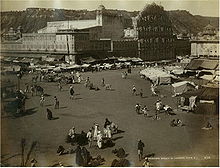Hawa Mahal (Hindi: हवा महल, "Palace of Winds" or “Palace of the Breeze”), is a palace in Jaipur. It was built in 1799 by Maharaja Sawai Pratap Singh and designed by Lal Chand Ustad in the form of the crown of Krishna, the Hindu god. Its unique five-storey exterior is also akin to the honeycomb of the beehive with its 953 small windows called jharokhas that are decorated with intricate lattic work.
The original intention of the lattice was to allow royal ladies to
observe everyday life in the street below without being seen, since they
had to observe strict "purdah" (face cover).
Built of red and pink sandstone, the palace is situated on the main thoroughfare in the heart of Jaipur’s business centre. It forms part of the City Palace, and extends to the Zenana or women's chambers, the chambers of the harem. It is particularly striking when viewed early in the morning, lit with the golden light of sunrise.

View of Hawa Mahal in 1875
Maharaja Sawai Jai singh, the ruler of Rajasthan of the Kachwaha clan, was the original planner and builder who built the Jaipur city in 1727. However, it was his grandson Sawai Pratap Singh, son of Maharaja Sawai Madhosingh I, who built the Hawa Mahal in 1799 as a continuation of the Royal City Palace. Pratap Singh's deep devotion to the Hindu god Lord Krishna is inferred to have prompted him to build it as a dedication, in the form of a Mukuta or headgear, adorning the Lord. Though no historical record is available to its exact history, it is conjectured that Royal family ladies, who were under strict observance of purdah (the practice of preventing women from being seen by men), had to be given opportunity to witness proceedings in the market centre and watch the royal processions and festivities sitting behind the stone carved screens. Hawa Mahal did just that in style, amidst its luxurious comforts and behind strict screened exclusivity, unseen by outsiders.
Royal family of Jaipur, during their reign, also used the palace as a hot weather retreat, during the suffocating summer season of Jaipur, for several years, since the unusually designed window screens provided the much needed cool breeze and ventilation.
The above text and image courtesy from wikipedia website. http://en.wikipedia.org/wiki/Hawa_Mahal
I have also one vintage black and white post card of Hawa Mahal, Jaipur in my collection. This is my Hawa Mahal Jaipur vintage post card.
Built of red and pink sandstone, the palace is situated on the main thoroughfare in the heart of Jaipur’s business centre. It forms part of the City Palace, and extends to the Zenana or women's chambers, the chambers of the harem. It is particularly striking when viewed early in the morning, lit with the golden light of sunrise.

Maharaja Sawai Jai singh, the ruler of Rajasthan of the Kachwaha clan, was the original planner and builder who built the Jaipur city in 1727. However, it was his grandson Sawai Pratap Singh, son of Maharaja Sawai Madhosingh I, who built the Hawa Mahal in 1799 as a continuation of the Royal City Palace. Pratap Singh's deep devotion to the Hindu god Lord Krishna is inferred to have prompted him to build it as a dedication, in the form of a Mukuta or headgear, adorning the Lord. Though no historical record is available to its exact history, it is conjectured that Royal family ladies, who were under strict observance of purdah (the practice of preventing women from being seen by men), had to be given opportunity to witness proceedings in the market centre and watch the royal processions and festivities sitting behind the stone carved screens. Hawa Mahal did just that in style, amidst its luxurious comforts and behind strict screened exclusivity, unseen by outsiders.
Royal family of Jaipur, during their reign, also used the palace as a hot weather retreat, during the suffocating summer season of Jaipur, for several years, since the unusually designed window screens provided the much needed cool breeze and ventilation.
The above text and image courtesy from wikipedia website. http://en.wikipedia.org/wiki/Hawa_Mahal
In my collection i have one piece of Hawa Mahal Jaipur Post Card issued by Indian Postal
Department in the year 1989 on the occasion of INDIA-89 World Philatelic
Exhibition held at New Delhi.This is 4 Rupees Air Mail Post Card.
I have also one vintage black and white post card of Hawa Mahal, Jaipur in my collection. This is my Hawa Mahal Jaipur vintage post card.




No comments:
Post a Comment